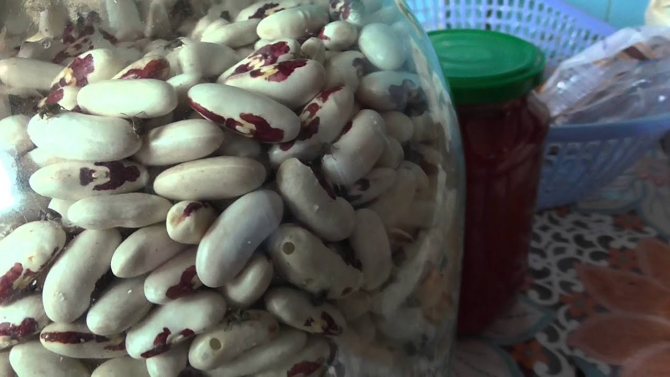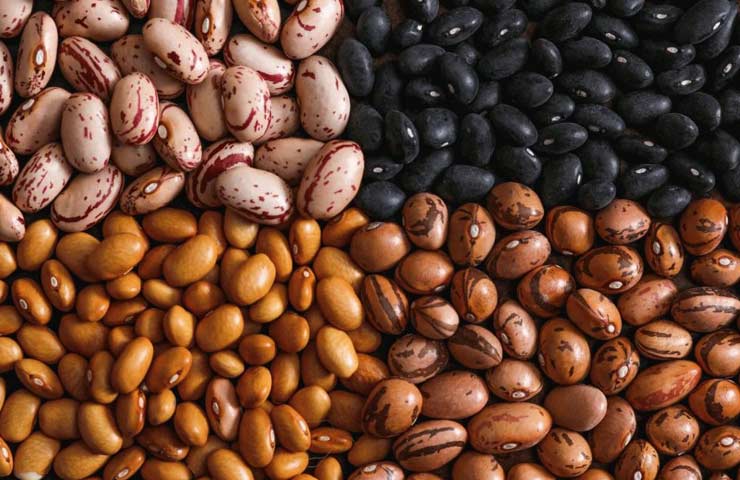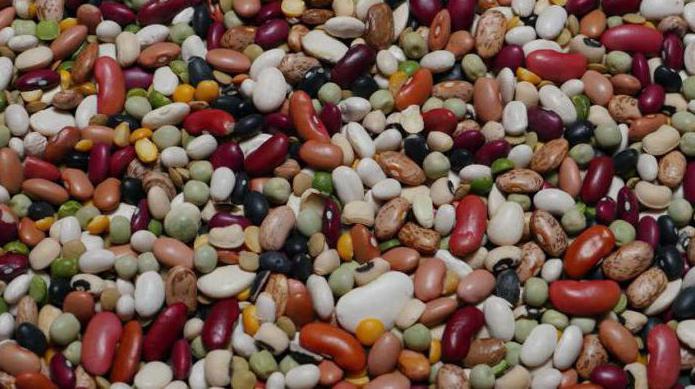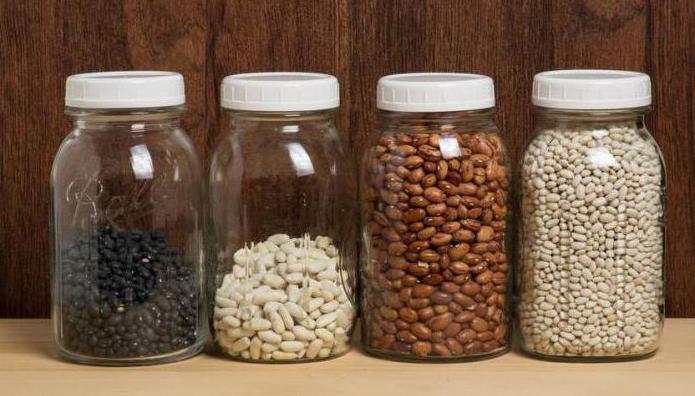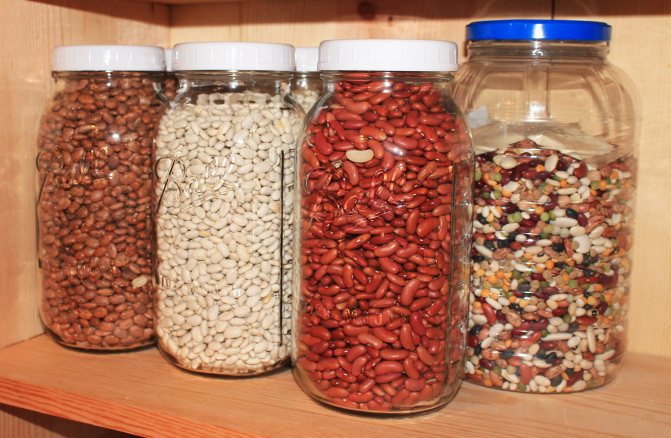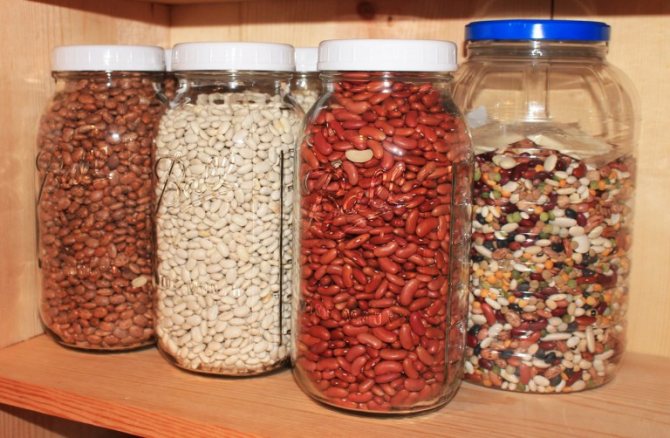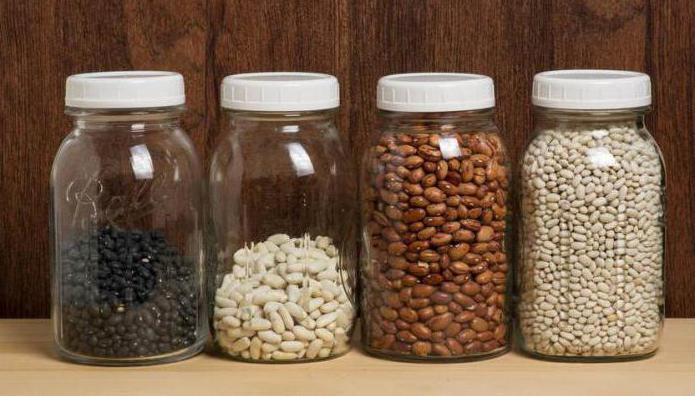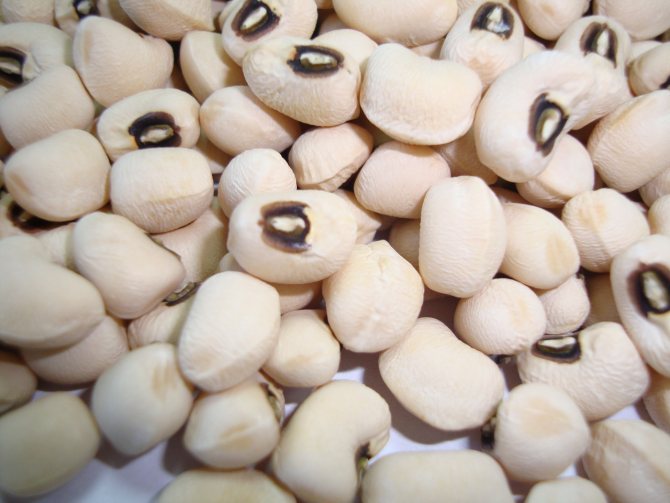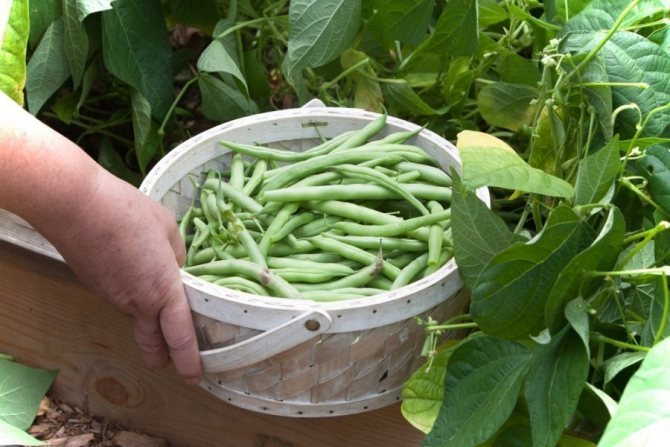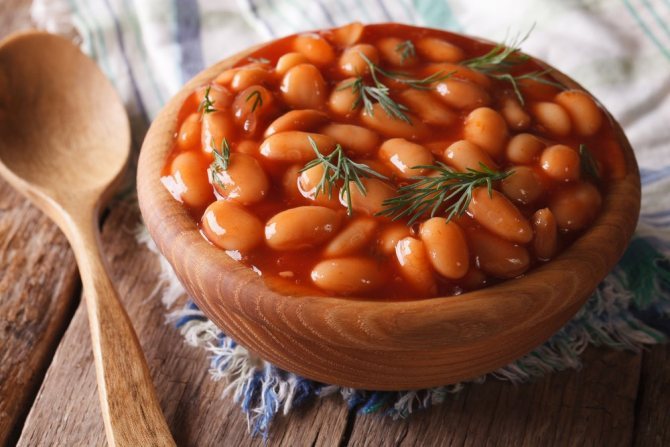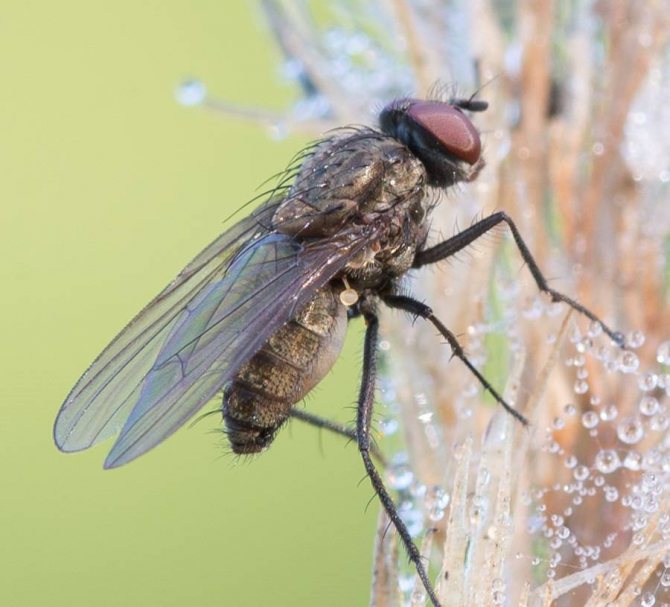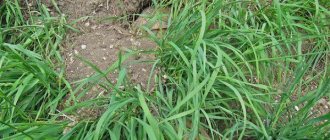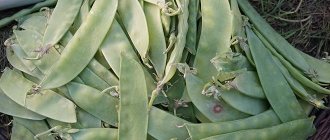What does a bean weevil look like and what does it eat?
The bean weevil is a small beetle from the weevil family (among the closest relatives are the pea and four-spot weevil). A brownish oval body is covered with copper-colored hairs. The insect has a miniature size of 2-5 mm, so it is difficult to study it in detail without a magnifying glass. If you look at what the bean weevil looks like in the photo, you will notice that the beetle has short elytra covered with gray spots. The hind legs are equipped with sharp teeth.

Bean weevil
Interesting!
Insects are very thermophilic and low temperatures are destructive for adults and offspring. At a temperature of 0 ° C, larvae die after 30 days, adult beetles after 15 days. At temperatures below 12 ° C, the vital activity of the bean weevil stops instantly.
Pests overwinter in storage facilities inside the grain or in the field under plant debris. Awakening occurs in the spring, when the ambient temperature reaches 12-15 ° C. The bean weevil has outstanding flying qualities. In search of a food base, she is able to cover a distance of up to 3 km.
Before the beans ripen, insects feed on the leaves of legumes and pollen. In the absence of food, caryopses can go without food for up to 3 months. A massive outbreak of pests on the bean plantation is noted after the end of the flowering phase.
Pests
Many housewives have noticed that up to ten larvae can develop in one bean grain. They gnaw through the passages, leaving waste products. Such stocks are unusable and cannot be used as seed.
Bean weevil
Beetle, about 2-5 mm, oval, has a black shell. Differs in active life and intensive reproduction. Destroys stocks of beans within one year.
The most effective method of struggle is low temperature. The planting material must be absolutely healthy. If the bugs are still wound up, the crops are treated with "Decis" or "Metafox" (two times is enough). The first is shortly before flowering, after ten days, repeat everything. You need to collect the beans before the pod dries and opens.
Sprout fly
The insect is gray in color with black stripes on the back (size about 5 mm). If pupae remain in the ground for the winter, then by May they will turn into flies. They lay eggs in the soil. If there is a drought, they will die, and there will be no offspring. The larvae usually attack fruits for sowing. These pests like cool air, then they are most active.


Slugs
These are large mollusks (up to 7 cm in length). They leave behind highly visible silvery-white traces. During the day, slugs are not visible, they are active in the dark. Slugs are most afraid of low humidity and temperatures below + 7 degrees.
It is easy to lure such pests into dark beer. To do this, a plastic bottle without a cap is buried in the ground to the very neck and up to half of its volume is filled with beer. Slugs just drown in liquid. For full effect, the procedure is repeated several times.
Aphid
It is quite small (only 1-5 mm). Preventive measures against it are powerless. A favorite place is young shoots and the lower parts of the leaves.Insects suck the juice out of them and carry viral diseases.
To eliminate pests, plants are watered with 4% green soap emulsion, liquid nettle fertilizers. These substances do not harm people, but aphids are very sensitive to them. Chemicals are used as a last resort. You can also plant dill, thyme, fennel next to the beans.
See also
Description of the 20 best varieties of ornamental beans, planting and care
To read
Features of the reproduction of bean weevil
In natural conditions, the reproduction of the bean weevil occurs during the ripening of the fruit. The female gnaws a depression in the bean seam and lays 15-20 white oblong eggs in it. The embryo length does not exceed 0.2 mm. Fertility of one female varies from 60 to 200 eggs. The weevil beetle is quite whimsical and its reproduction is possible under the appropriate conditions:
- optimal humidity 60-70%;
- the ambient temperature is 15-30 ° C, at a higher temperature regime the eggs die;
- the presence of a nutritional base.


Bean weevil
In the warm season, the development of the embryo lasts 7-14 days, at lower 35-40 days. The hatched bean weevil larvae penetrate deep into the bean and then into the grain itself. Newborns have 3 pairs of legs, are distinguished by mobility and the presence of bristles. Several dozen larvae can coexist in one bean seed at the same time, they eat the contents of the bean, gnaw tunnels in it. The stage of maturation of the larva lasts 3 weeks and ends with pupation.
The young beetle easily gnaws a hole in the bean and leaves it. The full development cycle of the caryopsis ends in September, October, and most often the larvae penetrate the storage with the harvest.
Important!
In the field, the female gives 2 generations, in the southern regions 3-4. In heated rooms, under favorable conditions, insects reproduce year-round.
How to dry beans
You need to dry beans at home in a natural way. The optimal place with the appropriate climate can be a veranda, a fence in the country or in the village, a gazebo or a balcony in an apartment. First, you should carefully remove the pods from the garden, remove the remnants of the earth and lay them in one layer on a wide tray, sheet of paper or spread cloth. Drying naturally can take up to 14 days. The dried beans will remain to be distributed in storage containers.
You may be interested in: Useful properties and contraindications of bean leaflets, use in treatment
It is not always possible to dry the product in a well-ventilated place. In this case, you can use one of the following household appliances for quick processing:
- oven;
- electric dryer.
Depending on the capacity of the equipment and the volume of production, the process can take from 1 to 5 hours. Proper storage of beans requires separating unsuitable grains or pods from suitable ones. Weed out those beans on which elements of mold, decay, damage or blackheads are visible. These defects signal that the product is infected with harmful bacteria that can be passed on to neighboring grains or pods.
What harm do beetles do
Beetles do not attack people, do not bite, but the harm to humans from them is significant. Infection of plants leads to a decrease in yield. Bean weevil begins to harm plants at the stage of their growth, damaging early crops. There have been cases where the bean harvest has been reduced by 70%. In addition to beans, insects are not averse to feasting on chickpeas, soybeans, and peas. The photo shows beans damaged by beetles.


The harm from the weevil
Important!
The larvae eat out nutrients from the grains, fill them with their waste products, which makes the beans in the future unsuitable for sowing and consumption. If contaminated beans enter the storage facility, the safety of the entire crop is endangered.
What are the ways to fight
After harvesting, the beans are dried and the excess is removed. It is better for the grains to lie in the sun for a couple of days. There are three main ways to fight:
- freezing;
- warming up;
- the use of chemicals.


If you suspect infestation, heat the legumes in the oven.
Potentially contaminated food is heated in an oven. First, you should soak the cereals in a saline solution. The parasites will float up and be easily removed from the surface of the water. Only then is heating used.
If the infection is insignificant, you can also leave the cereals in the freezer for several days. There are no effective ways to kill beetles. The only effective way is to throw away all overly contaminated foods.
Common types of pests
A small beetle, which is wound up from other cereals brought from the store, gets into cracks and corners, latches and poorly closed containers with cereals. He mercilessly eats stocks, leaving behind traces of vital activity. It is very difficult to get rid of them, because if there are acceptable conditions for their life, they actively reproduce. Their favorite delicacy is buckwheat, rice, semolina, millet, dried fruits. The appearance of bugs in the croup leads to its lumpiness; such a product cannot be eaten. Allergies, diarrhea, toxic manifestations - this is a list of possible troubles. Every effort should be made to remove these insects.
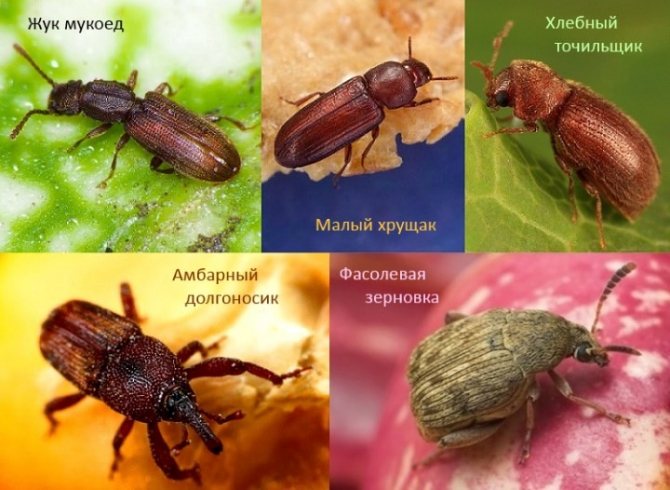

The ginger flour-eater grows in places with a large accumulation of cereals. Mills, bakeries, feed mills - this is a list of its most common habitats. If the food is heavily stale and shows signs of decay, this is a fertile breeding ground for insects. The appearance of bugs in the croup is indicated by characteristic traces: adhesion of particles into lumps, excrement and larvae.
The bread grinder is distinguished by high fertility and vitality, and it will not be at all easy to remove this insect. Tiny elongated beetles, 1.8–3.5 mm long, are brownish in color. Often they crawl out onto the windowsills and die there. They damage cereals, tea, coffee, grain, flour products, and also eat crackers, nuts, herbs. It is difficult to get rid of these insects: the difficulty lies in the fact that they practically do not go out of their hiding places. A visible appearance speaks of excessive reproduction of bugs in cereals and their high density.
Attention! Eating unprocessed foods contaminated with a bread grinder can seriously damage the body.
Where to store legumes - jars, bags or boxes?
The main container for storage is glass containers and bags made of natural fabric. Each of the methods has its own characteristics.
Bank
Conserving in glass containers is one of the most effective ways to avoid bugs. Before placing the fruits, about 4 cm of ash is poured onto the bottom of the container.
The containers are sealed with metal and glass lids. A polyethylene cover is not suitable for these purposes, as it is breathable.
The disadvantage of this method is the loss of the ability of the legumes to germinate.
The reason is that with such a tight sealing of the product, there is a lack of air not only for the growth of bugs, but also for the normal respiration of the fruit.


The method is suitable if the beans will be used for cooking.
Pouch or box
Linen bags and wooden boxes have their own advantages. The fact is that such a container allows the reserves to breathe. Before laying, the crop must be soaked for 30 minutes in salted water and dried well.
To prevent the appearance of bugs, dill seeds (20 g per 1 kg of legumes), cut garlic cloves (4 pieces per 1 kg of product) are placed on the bottom of the bags, boxes.
The bags should be placed in a dry place out of direct sunlight. For this purpose, a kitchen cabinet with sealed opaque doors is successfully used, which is located far from heating appliances, stove, oven.
How to keep beans for the winter?
Green beans are canned and frozen, and grain beans are stored differently, since special conditions must be created for them. The optimum environment for storing this product is temperature up to 10 ° C and humidity less than 50%. With such indicators, the bugs will not start.
Where and in what to store beans?
Peeled grains are best poured into cloth bags or glass jars with tight lids (metal or glass). Plastic covers will allow air to pass through. For prophylaxis, the bags are soaked in a solution of sodium chloride and completely dried.
Store only in a cool place (refrigerator, balcony or basement). The optimum air humidity is 50%.
In a warm room, the beans germinate. It is not recommended to eat sprouts.


How to prepare for storage?
The collected pods are pre-dried. They are laid out on tables in the yard, collected in bunches and hung on the veranda. When the pods are completely dry and the leaves begin to open slightly, it's time to start peeling.
Sometimes beans are heated before laying the grain. The temperature in the oven is at least 90 degrees.
How to store beans to avoid bugs?
It is important not only to harvest, but also to know how to store beans at home so that bugs do not start.
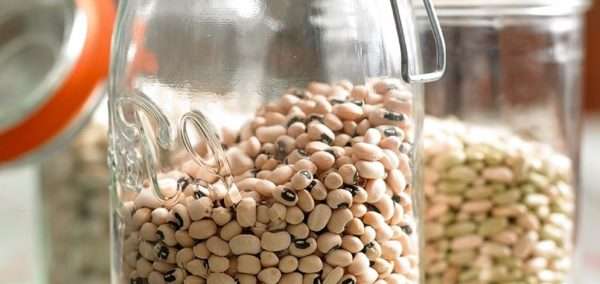

The legume crop is damaged by a pest - bean weevil.
It is a small bug whose larvae are invisible to the human eye. They are found inside the seeds.
Common causes of pests are:
- Ingress of larvae during fruiting. The stimulating factor is high air temperature and humidity.
- Neglect of the rules of storage, heat treatment in factories.
- Ingestion of pests from products stored nearby (flour, cereals, starch).
Beetles do great harm by eating fruits, making large moves, filling them with waste products.
The structure of the fruit is damaged, the seeds become unsuitable for sowing. A product with larvae must not be used for cooking.
In order to prevent the appearance of insects in stocks, it is important to adhere to simple recommendations.
- Before laying stocks, legumes should be warmed up at +60 degrees. The duration of the procedure is 61 minutes. The dried crop is placed in a glass container with a sealed lid. Fruits processed in this way are used for food, but are not suitable as planting material.
- In the conditions of an apartment, the refrigerator is the optimal place for storing the product. When the temperature drops to + 7 ... + 10 degrees, the stocks are moved to the insulated balcony, loggia, especially if the winter is not very cold. In a private house, a barn is a suitable storage place.
- The husked legumes are placed in the freezer for 3 days. A plastic bag is used as packaging. The product must be placed in glass containers or linen bags. Processed legumes can be used for sowing.
- When storing beans in cloth bags, add a few cloves of garlic, dill seeds. This condition helps repel insects. The presence of such additives allows you to store the product in a cool pantry.
- Ash is added to the glass container (10-20 g per 0.5 liter container). The container is sealed with a metal lid, so that the stock can be stored at room temperature.
- The pest is afraid of the smell of printing ink. Grains are placed in boxes, cardboard boxes. Newspapers in 2-3 layers are placed at the bottom of the container.
How to store bean seeds in winter?
The main conditions for good preservation in winter are two factors:
- The humidity level is not higher than 50%.
- The temperature is about +10 degrees.


Be sure to read:
How to prepare and store green onions for the winter: classics and modern recipes
Seeds can be saved in a variety of ways.
Storage at room temperature
The product placed indoors at temperatures above +10 degrees is subject to the risk of damage to the shell, reproduction of insect pests.
At room temperature, a caryopsis can lay up to 200 eggs. Within a few days, the entire crop will be unusable for human consumption and planting.
Dampness, humidity above 50% are the enemies of the fruit. They begin to grow moldy, a rotten smell appears, and the appearance of the product is lost.
Canning
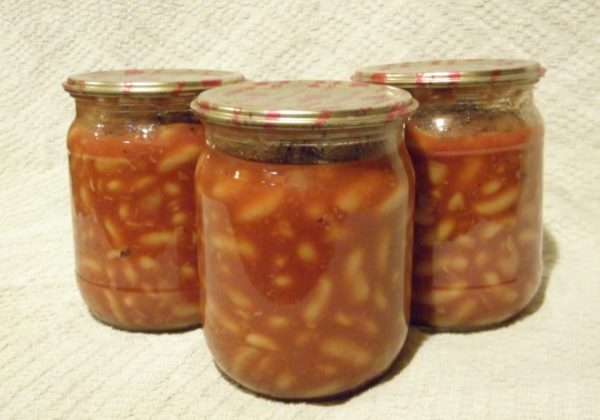

Canning is a great way to keep supplies for the winter.
The recipe is pretty simple:
- Soak 500 g of product for 5-7 hours in cold water.
- Drain the water and place the beans in a saucepan.
- Fill with 1 liter of water. Add 40 g sugar, the same amount of salt, cloves and black pepper to taste.
- Put the container on the stove, bring to a boil. Cook for 1.5 hours.
- Beans should be tasted with the tip of a knife. If the bean pierces easily, then the product is ready.
- Add 7 teaspoons of vinegar, turn off the stove immediately.
Ready-made legumes are placed in sterile containers and rolled hermetically.
Freezing
If you have a large freezer, the harvested crop can be frozen. This is a convenient way to avoid bugs.
The low temperature preserves the high quality and taste of all types of beans, including asparagus.
Refined grains are divided into small portions, placed in special plastic containers for freezing. Plastic bags are also used as containers.
How to dry beans?
If the crop is harvested on its own site, then the plants must be uprooted and spread out or hung in a dry room with sufficient ventilation.
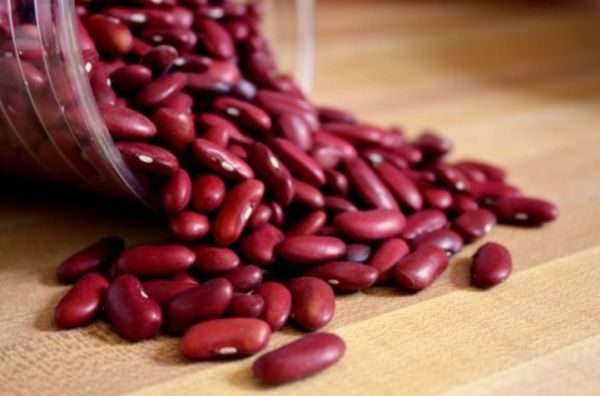

The attic of the house is ideal for this purpose. During the drying process, some of the fruits will fall out of the pods. To do this, you need to lay a clean cloth of bright light on the ground.
After the beans dry well, they are placed in cloth bags.
If the conditions do not allow drying the whole plants, then only the pods are harvested. They fit in small wooden boxes. The crop should be in a well-ventilated place.
Beans should be turned over regularly. This will help prevent mold growth. Pets should not enter the premises where the crop is located.
How to fight?
Often housewives do not know what to do with the bugs in the beans. Carefulness will save you from serious crop losses. Legumes need to be sorted frequently. If bugs have just appeared and have not yet managed to spoil many grains, cold or hot air treatment will help. Severely affected grains are discarded immediately. The rest of the beans are placed in the freezer or oven for a while.
Under the influence of extremely low or high temperatures, the larvae will not survive.
Small household tricks can also help protect legumes. For example, a caryopsis does not tolerate strong odors, so it is useful to put cloves of garlic in a husk in bags of beans. In the room where legumes are stored, cloves, bay leaves, or nutmeg are often laid out.
See also
What is beans - a vegetable or not, what a plant looks like, a description and a family Read
Important! Storage tanks for beans are periodically sanitized. This is an effective preventive measure.
How pests enter the kitchen


Even hermetically sealed tight bags do not guarantee that little uninvited guests will not appear in the cabinets. And there is no need to talk about cardboard boxes and fabric bags - these types of containers are preferred by insects more than others.
Why insects are dangerous in the kitchen:
- Rapid population growth: Small cereal bugs and other insects settle in beans, pasta, flour, starch, cereals and multiply exponentially, rendering food stocks unusable.
- Difficult to get rid of: even if the affected food is thrown away when pests are found, microscopic larvae can remain in the crevices of kitchen cabinets, seams and lids of storage containers, which will lead to a new wave of insect proliferation.
- A number of kitchen guests can pose a threat to human health. For example, cereals affected by a bread grinder cannot be used in cooking.
- The appearance of bugs at home causes natural discomfort and deprives the home kitchen of the usual comfort and safety.
Bean pests: who else?
- slugs. The delicate bean leaves are really to the taste of slugs. However, fighting slugs is a separate topic, which is devoted to a whole article on our website.


This is what beans look like after a visit from slugs.
- whiteflies, moths and other gnawing and sucking insects. They fight them in the same way as with aphids - both in terms of prevention and control.
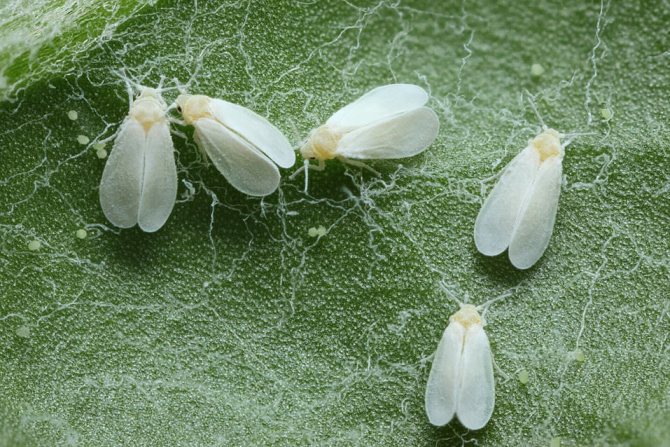

Bean Shelf Life
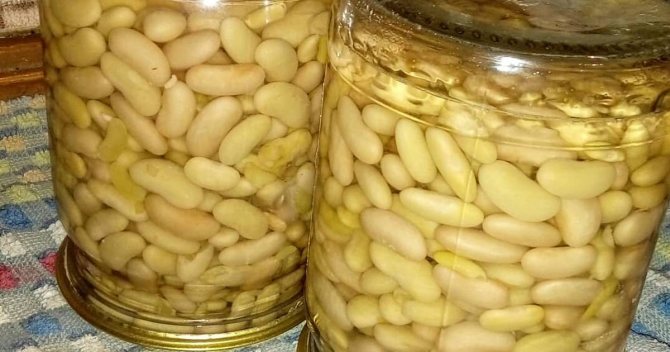

Another important question is how long beans are stored. This indicator can be different, depending on the method of its content. In open containers, for example, wooden boxes or containers, it can be stored for up to a year. But, periodically, you should monitor the condition of the product, weed out those grains on which larvae or mold appeared.
When frozen, the shelf life of seeds, pods or kernels is noticeably longer. It can be up to 2-3 years old. The product can be kept for the longest time in sterilized glass jars, rolled up with a lid. Dry beans can have a shelf life of up to 8 years.
Attention!
According to GOST, beans can be stored for 2 to 6 years. But, after 6 months, its taste and aroma will change noticeably, so it is recommended to consume it as early as possible in order to obtain the necessary useful values.
How to prepare for storage?
Since the caryopsis beetle penetrates the beans even at the stage of their ripening, before storing the harvested crop, it must be prepared. Before laying, the beans should be sorted out and dried. To do this, they need to be placed in an oven heated to 80-90 degrees for 5 minutes. After such heat treatment, the grains lose their ability to germinate, so such beans must be eaten. Many gardeners argue that in order to ensure a longer shelf life for beans, they should be separated from the pods.


Storage rules for green beans


Caryopsis larvae infect not only the beans of the plant, but also the pods. Thus, before making the bean blanks for the winter, the pods should also be sorted out. The best way to preserve the beneficial properties of the product is to freeze it. How to freeze green beans:
- Rinse the pods in cool running water.
- Remove areas with dark spots, dots, dents. Inspect for disease and pest damage.
- It is convenient to pre-cut into oblong pieces or finely chop.
- Blanch: pour boiling water over the raw materials and cool sharply in ice water or place in a snow mass.
- Dry the prepared semi-finished products with a towel or in an electric dryer. Do not allow ice particles to appear on the product before storage - this will contribute to the softening of the product and the loss of taste.
- Divide into bags or containers in portions. Re-freezing is not allowed.
note
Beans are one of the types of products that can be stored for a long time without losing their useful and taste qualities. However, there are some simple rules to follow to keep legumes fresh.
It is necessary to sort out the grains, checking for the appearance of weevils, store in a dry and cool room and ensure tightness.
The risk of seeing bugs in the product also exists when growing plants on your own in your backyard. Some bean pests start in legumes during the ripening stage and threaten the harvest even before harvest. Therefore, it is important to observe preventive measures and storage rules.
Where and in what to store beans?
Due to the fact that beans must be kept cold, the refrigerator is considered the only optimal place until such a period. If the beans are dry, they can be transferred to a canvas bag and then placed in the vegetable compartment or on the door.
To protect yourself as much as possible from the appearance of pests, you need to put unpeeled garlic cloves and dill seeds next to the beans. Such additions scare away pests. In winter, the beans can be transferred to the balcony.
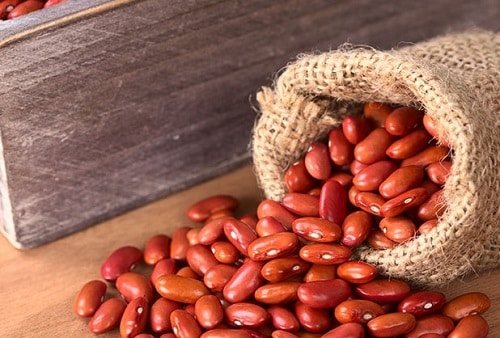

Choosing containers and premises: creating optimal conditions
Dry beans are placed in an airtight container: plastic bags, glass jars or plastic containers and placed in a dark, cool place with an air temperature not higher than +10 degrees and humidity up to 50%. To protect against kernels, the product is placed in the freezer, and in winter it is taken out to the balcony or terrace. Beans do not lose their flavor and nutritional characteristics after prolonged exposure to low temperatures.
Warm and humid air encourages seed germination.
If a canvas bag is chosen for storage, it must be prepared in advance: soak in a salt solution and dry. This measure serves as a reliable protection against bugs.
Sheds, pantries and cellars with a suitable temperature regime are considered ideal places for storing beans. Loggias and cellars are allowed as temporary storage, as they do not maintain a constant temperature and humidity.
Diseases
Beans, like any plant, are susceptible to disease. Often, such problems arise due to improper agricultural technology. Often gardeners do not understand why young beans turn black. There may be several reasons. And they are all associated with fungal or viral infections.
Powdery mildew
Initially, the leaves are covered with a whitish bloom, which then turns into gray. Reduces the yield of beans by a quarter.
Anthracnose
The leaves and stems of plants are covered with depressed spots of an oblong shape. Over time, they acquire a brownish-red color. All this leads to necrosis.
See also
What is the difference between white beans and red beans, which is better and healthier, what is the difference Read


White rot
Most often appears where the plant is in contact with the ground. It all starts with the appearance of watery spots, which are then covered with mycelium (similar to cotton wool).
Root rot
May be of bacterial origin. It is very dangerous for seedlings and young plants. It appears as hard pads with a white or lilac bloom. There may be constrictions on the stems that prevent nutrients from reaching the plants.
Bean mosaic
Bugs and aphids become carriers. Dark and light green spots can be seen on the leaves, forming a pattern. Then they turn into bubbles and deform the leaves. The process of plant development slows down.
Bacterial spot
It is very difficult to deal with it. It is characterized by dark brown spots with yellow edges. Due to this disease, the beans become dwarf, and the beans cannot fully ripen.
The fight gives results only in the initial stage of disease. The same measures are used as for fungal diseases.
Bean diseases and prevention
It may be interesting Moles in the garden and garden, methods of struggle
Before proceeding with the preparation of beans for storage for the winter, you should make sure not only that there are no pests and their larvae, but also that the harvest is healthy. For example, a whitish bloom on beans is a sign of powdery mildew damage. This disease leads to moldy beans. The softness and characteristic odor of dampness indicates a disease of the fruit with white rot. Infected grains must be removed.
Effective preventive measures against bugs in seed beans:
- Spread the beans on a dry surface in the open air or in a ventilated place. Can be left in direct sunlight (for example, hung on a balcony or on a hedge, gathering in bunches).
- Dry for 10-14 days. During this period, the bean pod opens slightly and the grain hardens.
- Sort out the harvested grains carefully. Check for pest damage by larvae, and also make sure that there are no diseases - white rot and powdery mildew.
- After drying, place in the freezer for several hours - this will kill the larvae of the bean weevil, while maintaining the germination of the beans.
- If the harvested beans are not planned to be used for sowing, they can be calcined in the oven at a temperature of up to 60 ° C. Exposure to high temperatures destroys pest larvae.
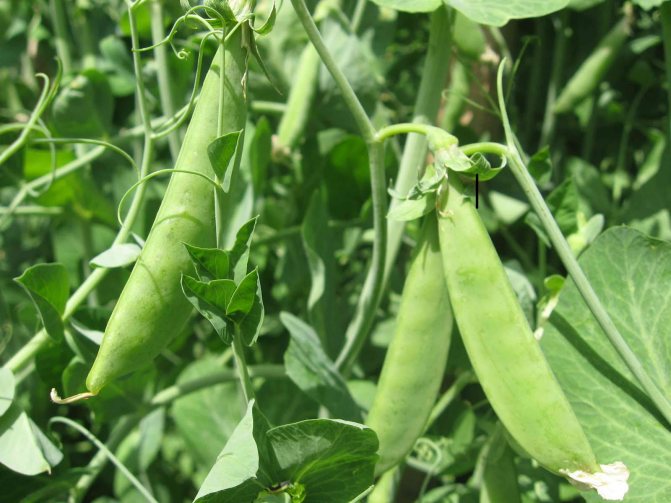

Radical ways to get rid of bugs
To get rid of the unpleasant "neighborhood" will allow primitive measures: heating the cereal in the oven, keeping it in a saline solution before cooking. In this case, black insects will quickly float to the surface, it will not be difficult to remove them. With a large percentage of damage to the product, it is better to get rid of the cereal.


For preventive purposes, the following steps are taken:
- Surviving cereals are stored in airtight bags or tightly closed containers.
- To get rid of insects and larvae, treating the jar with soapy water and subsequent drying will help.
- Examine other foods for signs of pests.
- The affected cereals are placed in the freezer compartment of the refrigerator.
- Treatment of all surfaces with soapy water will help to get rid of the subsequent appearance of pests, after which tables, cabinets and window sills are wiped with a vinegar 9% solution.
- Treat cracks and possible penetration points with boiling water.
How to get rid of bugs in beans?
In order to prevent bugs from appearing, it is necessary to carefully examine each fruit when planting for any damage, traces of insects, to harvest in a timely manner, avoiding cracking of the seeds.
For prophylactic purposes, before flowering, plants can be treated with the preparations "Metafox", "Decis".
If insects suddenly appear in an already harvested and dried crop, then in most cases the entire product must be thrown away.
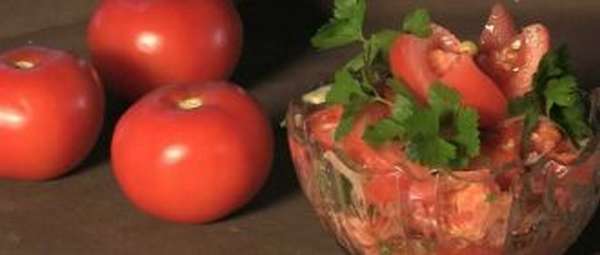

Be sure to read:
How to store tomatoes properly - keeping fresh fruits until winter 9 ways
Even if all stocks are carefully sorted out, it will not be possible to completely get rid of all infected fruits. The eggs of the beetles are found inside the fruit, so it is difficult to identify damaged specimens from the outside.
The damaged product is not suitable for cooking. The germination capacity of such seeds is also zero.
Protective measures
To protect plants from these diseases, it is necessary to get rid of pests, which often become their carriers. You should also organize the plantings for optimal growth conditions, maintain humidity at the desired level.
Preventive
If the summer resident is afraid that the beans will be affected by pests, he should prevent their appearance. Most often, for this, it is enough to use folk remedies that recommend covering the soil around the plants with dried nettles.Also, plantings can be watered with garlic broth, which will also scare away pests.
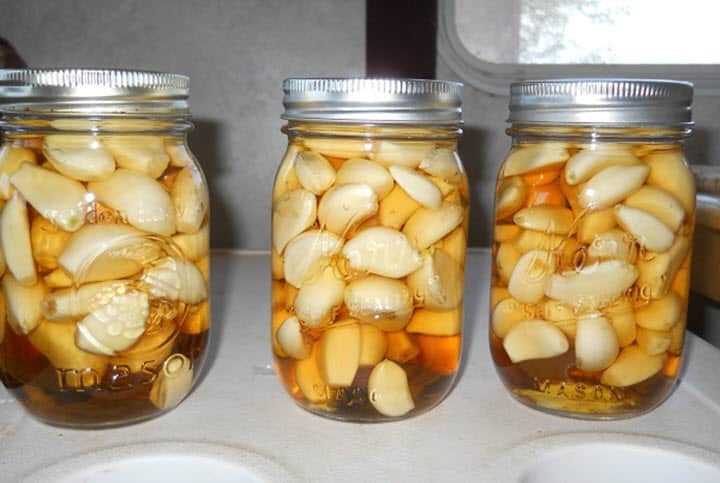

Storage at room temperature


The most affordable way to store a product at room temperature. To protect beans from bugs, you first need to:
- Freeze food for 20 minutes in the freezer or dry in the oven for 30 minutes.
- Separate whole pods or grains from damaged ones.
- Avoid washing the beans and any interactions with moisture.
Containers for storage at room temperature should be used as dry as possible, they should be tightly sealed without letting in air. You can store it in a table or closet. It is important to place the container as far away from the heating elements as possible, otherwise sprouts will form.
Where do insects come from?
Many housewives who carefully observe cleanliness in the house often ask themselves the question: why are bugs in the beans? Most often, insects appear due to the fact that sanitary standards are poorly observed in factories. Such consequences can be caused by neglect of heat treatment, violation of storage rules. That is why beans that are sold in a store may initially contain pests.
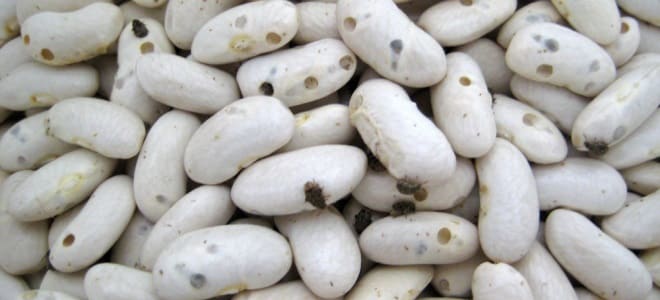

Also, beetles can appear in beans, moving into it from neighboring products. Most often, bugs run over to beans from flour, starch.
[collapse]
other methods
If it is not possible to place the harvested crop in a cool place, there are other ways to keep the crop at room temperature. Dill (seeds) and chopped garlic are placed in a container with beans. This will protect the crop from pest bugs. Proportions: for 1 kilogram of beans, about 15-20 grams of dill and three cloves of garlic are taken.
Another interesting option for how to store beans is presented below. The culture is placed in glass jars, on the bottom of which 30-40 millimeters of ash are poured in advance. After the harvest has been laid, the container is tightened with a metal lid. This method allows you to preserve the fruit for up to 5 years. There is a significant drawback in this method - the fruits lose their ability to grow, which is due to the lack of oxygen in a sealed container. This option is only acceptable for edible beans. Sometimes beans are simply canned in the standard way for many crops, while retaining all the vitamins and nutrients.

